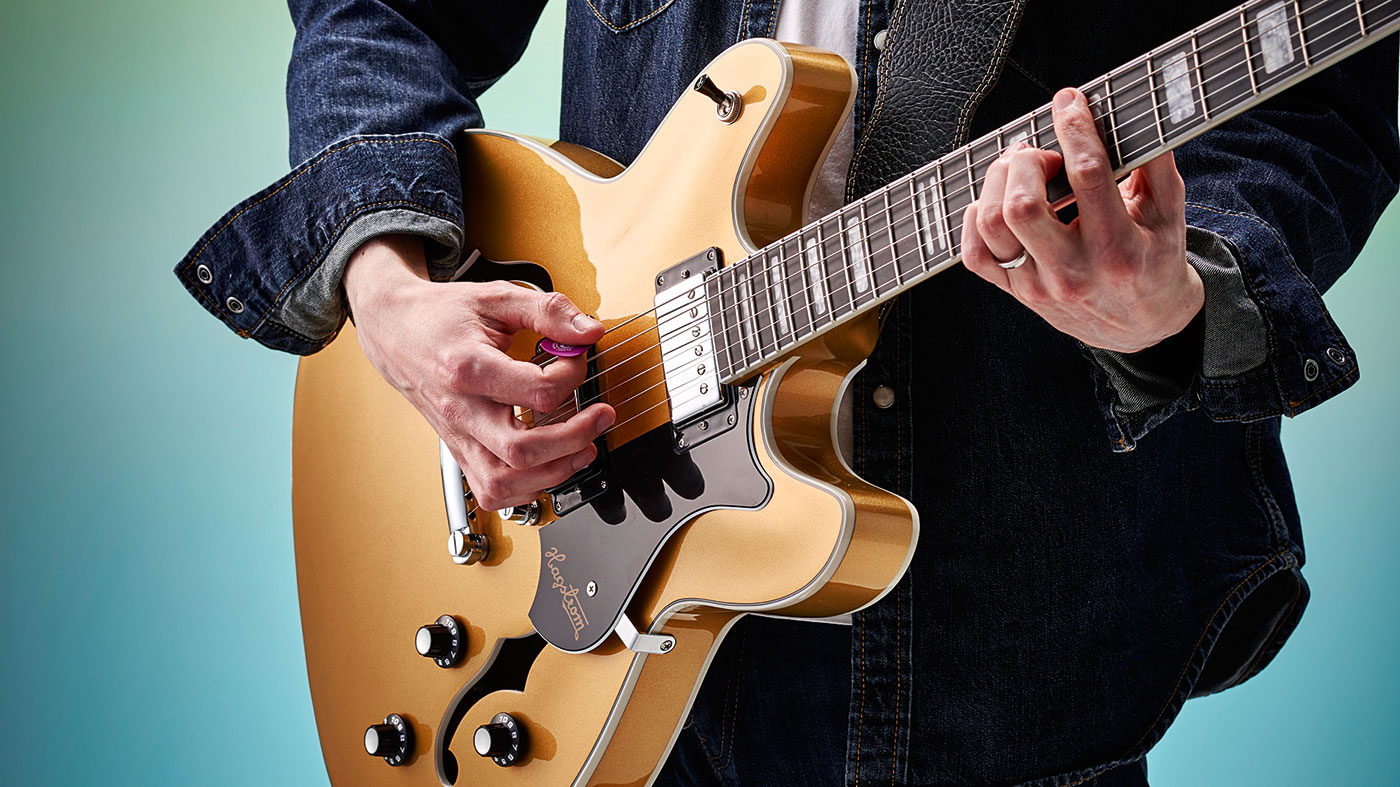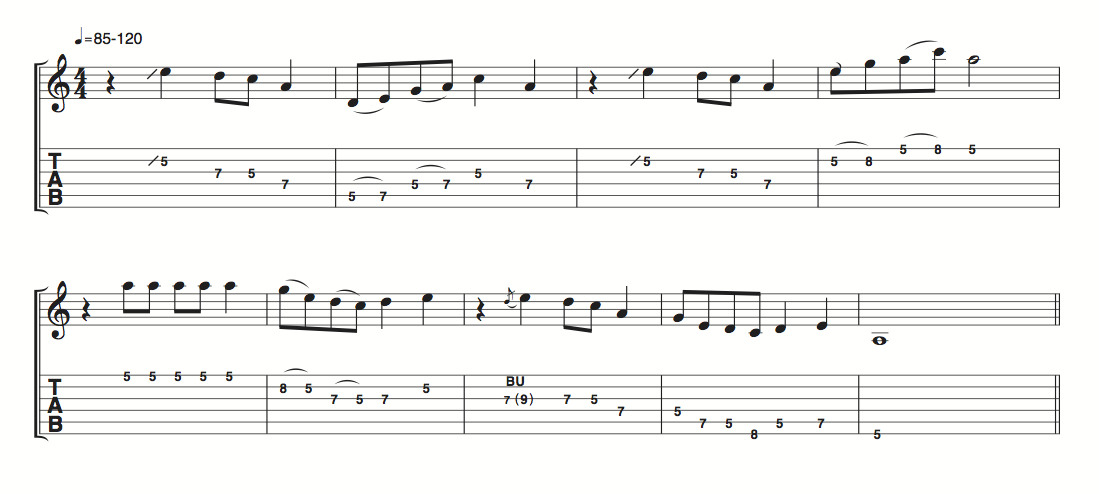How to make your guitar practice more effective
This 5-step, 30-minute daily routine will improve your playing

There's a big difference between practicing and playing. Playing the guitar is when you're performing, jamming or sitting on the sofa, watching TV and annoying your long-suffering family with unplugged licks.
Practising can still be fun, but your practice time must have a direction
Practising, on the other hand, is a more focused section of your guitar time where you work on basic techniques, increase your theory and guitar knowledge, and work on the details of the songs you're learning.
Without allocated practice time you're in danger of playing songs to a mediocre standard and developing bad habits that will be hard to undo at a later stage of your playing career.
Don't panic! We're not going to load you down with irrelevant technical exercises that will bore you to death and make you dread touching the guitar.
Practising can still be fun, but the important thing to remember is that your practice time must have a direction, otherwise you will end up drifting into playing what you already know or just playing songs that you like, which will slow your progress.
This lesson takes you step by step through a 30-minute practice routine that you should aim to do every day. While there are a few technical exercises (about 10 minutes' worth), the bulk of your practice time will be spent working on developing your lead and rhythm playing skills and really nailing the songs you want to play.
Take our word for it, this routine will make a huge difference to your abilities that will shine through when you're playing in real situations.
Want all the hottest music and gear news, reviews, deals, features and more, direct to your inbox? Sign up here.
1. Warm-up and technique tune-up: ten minutes overall
Warm-up (two minutes):
A warm-up is the first part of your practice regime. It's important to limber up and get the blood flowing before you get into anything too challenging. Start by shaking your hands as if you were shaking them dry, then gently massage them. Once you've loosened up, play something simple. Strum some open chords, or play each fret on each string as you try to name the notes.
Alternate picking (two minutes):
An essential technique that every guitarist should be proficient in, this involves strictly alternating between downstrokes and upstrokes.
A lot of players naturally use the less efficient 'all downstrokes' method, but you should train your picking hand to alternate automatically. Two minutes a day playing the spider exercise will help you nail this technique.
Example one tab (right-click to download)
Improvers: if you feel comfortable with this pattern, extend it to go across all six strings and play four notes per metronome click at about 60bpm to 70bpm.
Scales (three minutes):
It might not seem very rock 'n' roll to practise scales, but being fluent with them is essential if you want to get into lead playing. Scales help you move around the guitar confidently, which in turn allows you to play what you want without hesitation.
At this stage you should focus on the minor pentatonic scale and the major scale, shown in bar one and two respectively in example two below. You must play each of the scales at a different fret every day to get comfortable playing in lots of different keys.
Example two tab (right-click to download)
Hammer-ons and pull-offs (three minutes):
An important part of guitar playing is legato phrasing. Legato means 'smoothly' and is achieved on the guitar by playing hammer-ons and pull-offs. It's good to drill these techniques in isolation so that they're super accurate when you use them in riffs and solos.
Because these techniques are usually built on scales, it makes sense to develop exercises out of scales. Example three uses the A minor pentatonic scale but you can use any scale you wish. The major scale is a good way to give all four fingers a workout, by the way.
Example three tab (right-click to download)
2. Rhythm playing: five minutes overall
Good rhythm guitar playing is much more important than lead playing. Even the longest guitar solos only take up ten per cent of a song, with the rest of the track being rhythm playing.
It pays to have chord knowledge, a good strumming technique and solid timing. Once again, the best approach is to drill these things in isolation.
The key to successful strumming is keeping your hand in constant motion, even when it's not strumming the guitar. This takes a little while to get used to but, like alternate picking, once it's an automatic process you won't think about it. As important as they are, though, your strumming action and the different patterns shouldn't be your only focus. Make sure every note of every chord rings out clearly.
There shouldn't be any fret buzz (ensure you play as close to the frets as possible) and don't strum any notes that aren't in the chord (like the fifth and sixth strings on a D chord). These seemingly small details make the difference between an average performance and a professional sounding one.
Rhythm playing that involves powerchords is a little different from chord strumming. This is because powerchords are used for their aggressive sound, so they often sound best when they're played using only downstrokes.
While this provides a strong attack, it makes it harder to play fluently and in time so pay extra attention to your timing. Be sure to practise with backing tracks or a metronome, otherwise you'll find yourself lacking the precision that powerchord playing requires.
Example four - strumming pattern:
Your hand should stay in constant motion and ensure you're getting the rhythm right.
Example four tab (right-click to download)
Example five - 16th note strumming pattern:
This exercise uses four strums per beat (or metronome click). Like the previous examples, keep your wrist relaxed and in constant motion to make your strumming as fluent as possible.
Example five tab (right-click to download)
Example six - powerchord practise:
Powerchord rhythm playing doesn't use the 'constant motion' method of chord playing so you need to be really aware of your timing. Play with a metronome to ensure you're nailing it.
Example six tab (right-click to download)
3. Soloing (optional): five minutes overall
Soloing can be intimidating if you're new to playing. You may have tried to play a solo before but found it too difficult. If so, we've written an easy solo that you can add to your practice routine - try it at a slower speed first.
Break the solo down and tackle it bit by bit - don't move onto the next phrase until you can play the previous one without errors. Gradually, you'll build up to the complete solo. Once you've nailed the solo at a slow speed, try playing it at the faster speed.
Example seven tab (right-click to download)
Beginners: if you find example seven a struggle, you may not be ready for soloing. Instead of working on your soloing (for a few weeks anyway), spend this time working on any songs you're learning.
4. Improvising? Set a goal
When you feel comfortable with example seven, you can use this time to develop your improvising skills. If you're new to improvising, start by re-ordering the phrases in example seven. This is the first step towards good solos. If you want to create your own phrases, go for it!
To make best use of your practise time, establish a goal for your improvisations otherwise you're likely to end up just playing what's familiar, which is missing the point of practising.
Set yourself specific targets for what you want achieve each time you practise. It might be, 'I need to improve the tuning of my bends' or 'I want to use more hammer-ons and pull-offs in my solos'.
Example eight - a solo to improve hammer-ons and pull-offs:
This is an example of a solo using phrases that include hammer-ons and pull-offs. You don't necessarily have to learn this, it's just an example of how to target a specific technique when you practise.
Example eight tab (right-click to download)
5. Practising songs: ten minutes (five minutes optional) overall
This is an area where it's really important to recognise the difference between playing and practising songs. You probably play songs all the time, but practising them is a different process.
Performing a song well is about more than simply knowing where the various notes and chords go. You should use this time to focus on the details of really playing a song well.
Timing, tuning and accuracy should always be in your mind as you practise your preferred songs. It's easy to play with no metronome or backing track, but your timing will drift - most likely without you even noticing.
As often as possible, play along to a time-keeping device, such as a metronome click, drum beat or backing track. This will make your playing as tight as possible and it also builds a better 'internal' sense of time so that you'll be able to keep better time when you play unaccompanied.
People often think that tuning only relates to the guitar itself or bad string bending, but if you fret the strings too hard or allow your fingers to drag the strings from their natural resting position you'll be out of tune. This is a real problem with chords where all six strings could end up out of tune one way or another. Paying attention to these details will help you sound more professional and accurate.
Accuracy is another overlooked aspect of guitar playing. Can you hear fret buzz when you play? Is your thumb position preventing you from playing on the tips of your fingers? When you alternate-pick do any of the notes sound muffled?
All of these problems can be overcome with some attention to detail. Don't just play; always make sure you're improving a specific aspect of each song.
MusicRadar is the number one website for music-makers of all kinds, be they guitarists, drummers, keyboard players, DJs or producers...
- GEAR: We help musicians find the best gear with top-ranking gear round-ups and high-quality, authoritative reviews by a wide team of highly experienced experts.
- TIPS: We also provide tuition, from bite-sized tips to advanced work-outs and guidance from recognised musicians and stars.
- STARS: We talk to musicians and stars about their creative processes, and the nuts and bolts of their gear and technique. We give fans an insight into the craft of music-making that no other music website can.








